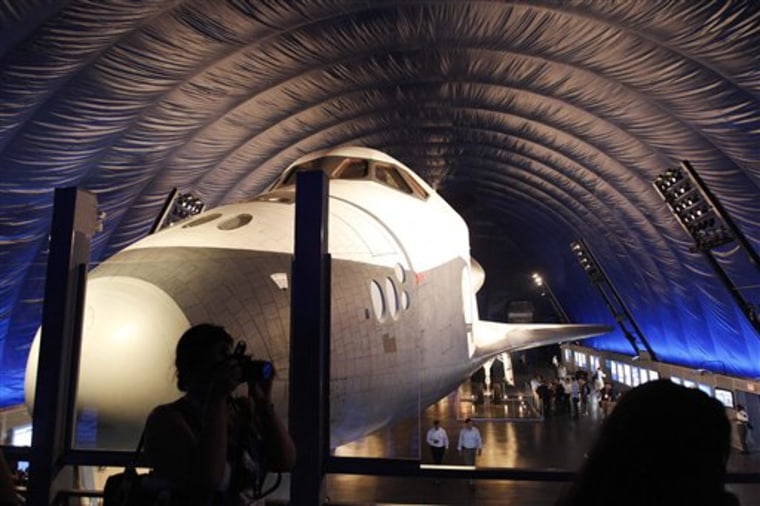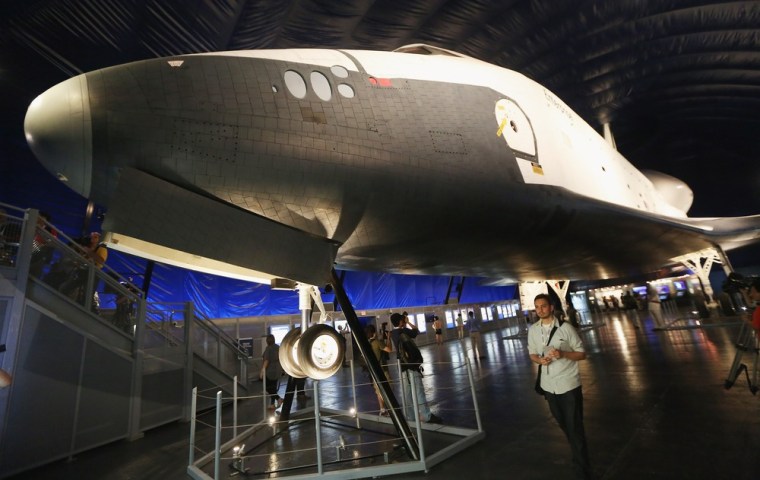The last time some New Yorkers saw the space shuttle Enterprise, it was zipping around the city, riding piggyback on top of a modified jumbo jet past the Statue of Liberty and other local landmarks.
Others got to lay eyes on it as it sailed up the Hudson River on a barge.
Today, following its April and June sojourns, the piece of NASA history is on the move no more.
The Enterprise, a 150,000-pound mammoth of a flying machine, goes on public display Thursday at the Intrepid Sea, Air and Space Museum's new Space Shuttle Pavilion. Encased in the center of an accommodating inflatable dome, the shuttle is available for visitors to admire up close from just feet away.
At 57 feet (17 meters) wide and 137 feet (42 meters) long — with a 78-foot (24-meter) wingspan to boot — the Enterprise is an imposing figure with quite a presence in its new home.
The prototype space shuttle, which was built in 1976, was NASA's first. Though it never actually flew a mission into outer space, it performed critical tests in Earth's atmosphere and is widely credited with paving the way for five space shuttles that followed.
Of the six shuttles that NASA built, only four remain: Enterprise plus Discovery, Atlantis and Endeavour. The other two experienced disasters during their missions, killing their crews: Challenger exploded in 1986 and Columbia disintegrated in 2003.
President Richard Nixon first announced NASA's intention to build the shuttle fleet in 1972 amid heightened tensions during the Cold War. With U.S. officials fearing the Soviet Union would dominate the novel realm of space travel, the shuttle was designed to be a reusable spacecraft that could also land safely — allowing NASA to conduct launches more frequently and with greater efficiency.
Previous spacecraft couldn't make a runway landing, nor could they be reused for future missions.
Enterprise was given its name as the result of a petition campaign led by fans of the "Star Trek" TV show, which featured a starship by the same name.
When tests including the Enterprise began in 1977, the shuttle would sit atop a 747 carrier aircraft that helped get it off the ground. Once it reached an altitude of hundreds of thousands of feet, the Enterprise would separate from the plane, and two pilots would glide the shuttle for several minutes before making a smooth landing. This was thanks in part to an aerodynamically designed tail cone.
Fred Haise, an Apollo 13 astronaut who piloted the Enterprise on five flights, said flying the shuttle was "nearly perfect."
"It's something exciting, especially when you put five years of development into getting it ready," said Haise, 78.

Of the moment right after his first takeoff in the Enterprise, Haise said: "I was immediately happy and grateful."
The Enterprise exhibit is expected to boost attendance at the Intrepid museum by a third, bringing nearly 1.3 million people a year to the repurposed World War II aircraft carrier docked on Manhattan's West Side. The museum, which opened in 1982, houses an array of historic aircraft, including bombers, spy planes and the Concorde, plus a space-flown Russian Soyuz capsule and the USS Growler, a strategic missile submarine that visitors can tour.
For years, the Enterprise had been on exhibit at the Smithsonian's National Air and Space Museum near Washington, but it was transferred to the Intrepid museum to make room for Discovery. Endeavour is destined to go on display at the California Science Center in Los Angeles, while Atlantis will make its home at Kennedy Space Center's visitor center in Florida.
Jessica Williams, Intrepid's curator of history, said the Enterprise is a worthy addition to her museum's lineup. "This is an amazing, original space-related artifact, the prototype for all space shuttles, so it really adds an even deeper exploration of the American space program to the museum," she said.
Officials said the Enterprise will be parked on the Intrepid's deck for two to three years, after which time the museum will build it permanent housing.
Pictures from the Enterprise's journey:
- April: Enterprise gets set for trip to Big Apple
- April: Shuttle takes an aerial tour of New York
- June: Enterprise takes to the seas
- June: Enterprise heads up the Hudson River
- June: Crane lowers Enterprise onto museum's deck
- July: First look at the Enterprise exhibit
This report also includes information from Reuters and NBCNews.com.
